Index


Review: Enough power to defeat GTX 780 Ti
The EVGA GTX 780 Classified has been dethroned as the company’s fastest non-Titan card following the introduction of the GTX 780 Ti Classified, which became the new alpha dog.
However, even the plain GTX 780 Classified is still a very attractive card and here is why. As the Ti launched and superseded the GTX 780, it became quite a bit cheaper. Right now you can pick up a GTX 780 Classified for about €70 less than a reference GTX 780 Ti card and it’s a whopping €200 cheaper than the GTX 780 Ti Classified.
The GTX 780 debuted at €620 and today you can have the GTX 780 Classified for €480.
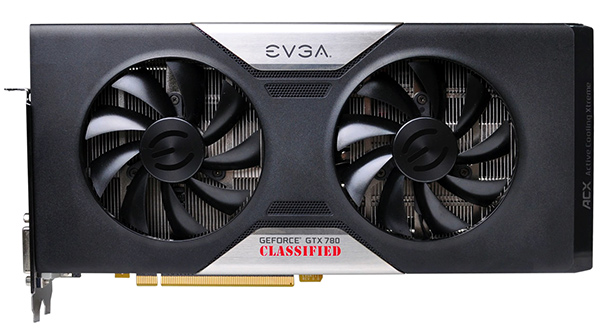
EVGA’s Classified series cards are known for their all-custom PCBs and spruced up power components, which provide more power stability and overclocking potential. As a result, we were able to squeeze out a lot of performance out of the card and beat the reference GTX 780 Ti. The custom cooler is quiet, too. The ACX cooler features a huge heatsink and two 90mm fans.
Before we move to test results let’s refresh our memory. If you know enough about the GTX 780 save your time and feel free to skip to the next page.
Nvidia’s Kepler architecture has been around for a while. Kepler was officially launched in March 2012 and became known as the Geforce 600 series. The top of the line was the GK104-based Geforce GTX 680 card that stood its ground for quite some time. This was a 28nm chip that stayed with us for years and it’s on sale even today in GTX 760 / 770 based mainstream cards.
Then the world’s attention shifted to the GK110, a massive new chip that was announced at Computex 2012 and finally released in November 2012 as the Tesla K20 compute card. This one was based on the brand new, 7-billion transistor GK110 28nm core.
The gaming world met the GK110 chip in late February 2013 as it debuted in the fastest graphics card at the time, the Geforce GTX Titan. The Titan has 6GB of GDDR5 memory, 2688 Shader processors, 224 texture mapping units and 48 ROPs or render output units. The card is clocked at 837MHz base clock and 876 MHz boost clock and was the fastest card for some time. The problem was the $999 price which was enough to burn a huge hole in most wallets.
It is interesting to note that the Titan got a lot of flak for its price, but that did not deter Nvidia. In fact, the company launched an even more expensive card this year, the $2,999 Titan Z.
The Geforce GTX 780 was the first desktop card in the GTX 700 series and the first mass market implementation of the GK110. It launched in May 2013, with 2304 CUDA cores, 863MHz base GPU clock, 192 texture mapping units (TMUs), 48 render output units (ROPs) and 3GB of GDDR5 memory running at 1502MHz on a 384-bit memory bus. The EVGA GTX 780 Classified works at a 993MHz base clock, which points to a significant performance boost over reference cards. Unfortunately the memory is still running on reference clocks, i.e. 6008MHz (effective GDDR5). This is typical of EVGA, since the company rarely overclocks memory.
Basically the GTX 780 is a watered down Titan. The GK110 is made out of clusters and Titan has 14 clusters with 192 Shader cores each. The Geforce GTX 780 has 12 of these cores enabled and the new comer Geforce GTX 780 Ti comes with a record number of 2880 shades, which translates to 15 clusters enabled.
Specification wise the GTX 780 ended up with 50% more CUDA cores than its predecessor, the GTX 680. This among other things gives the GTX 780 card a significant performance boost, although the GK110 is based on the Kepler architecture used in the GTX 680. The GK104 chip used in the GTX 680 has 1536 CUDA cores. The GTX 780 has a 384-bit bus while the GTX 680 is limited to a 256-bit interface, but the memory speed on both cards is 6008MHz.The frame buffer was increased from 2048MB to 3072MB of GDDR5 memory.
Compared to the GTX Titan ($999), the GTX 780 debuted at a more attractive price of $649. Nvidia’s response to AMD’s new R9 290X was to slash the price of the GTX 780 by $150 and launch the full GK110 Geforce GTX 780 Ti.
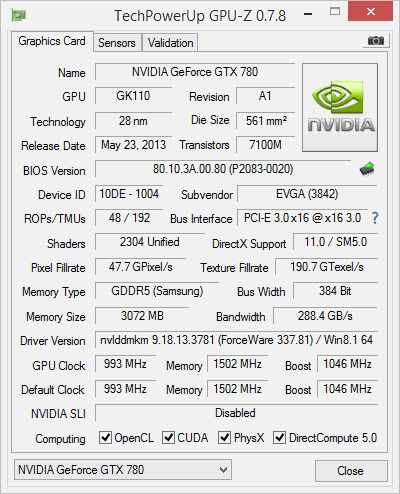
The ACX Classified cooler has considerably bigger dissipation surface compared to standard two slot coolers. This was possible by designing a custom PCB, which is about 3cm higher and 1.5cm longer than reference. The card is about 28cm in length, or 11 inches. A huge heatsink was placed on top of entire PCB, and the cooler can dissipate roughly 450W of heat without generating a lot of noise in the process.

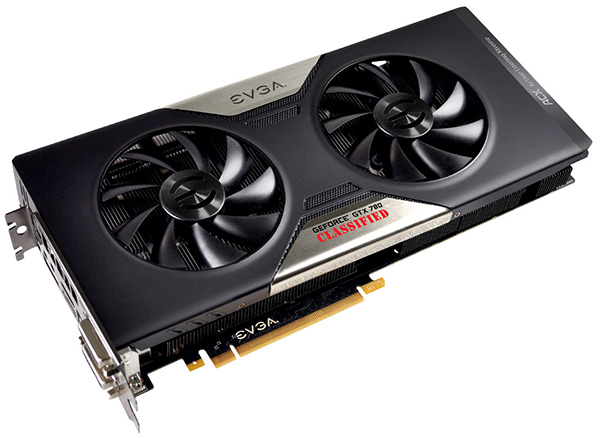
This is what the Classified looks next to the reference GTX 780 card. The size of the custom cooler and PCB is clearly visible.
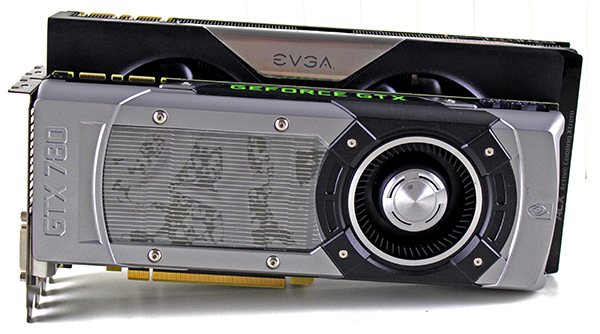
Although it is factory overclocked, the GTX 780 Classified is a little bit quieter in 3D than the reference model, in other words – it’s not loud. EVGA extended the power limitation, by 75W adding a second 8-pin power connector. EVGA recommends a 600 watt (or higher) PSU with 42A on the +12v rail.
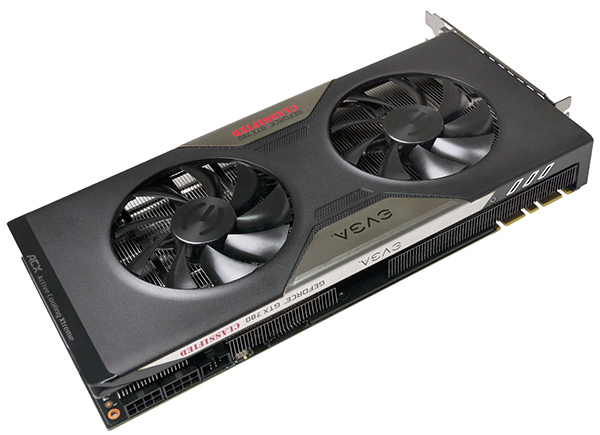
Next to the power connectors you’ll find the EVBOT connector, which can be used for sensor readouts as well as overvolting. The BIOS switch is there, too, along with the voltage monitor connector, but you need to get an EVGA add-on to use them. The first BIOS functions as a fail-safe and the second one is a stock factory OC BIOS. You can find more about dual BIOS feature in this
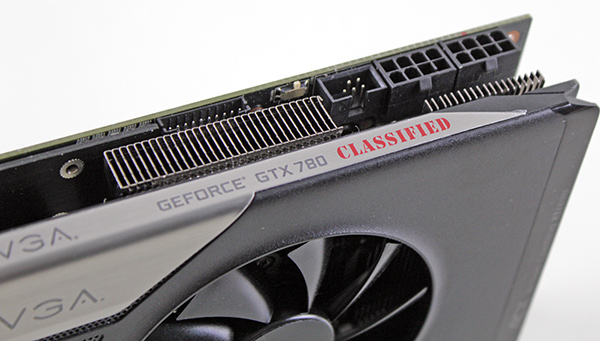
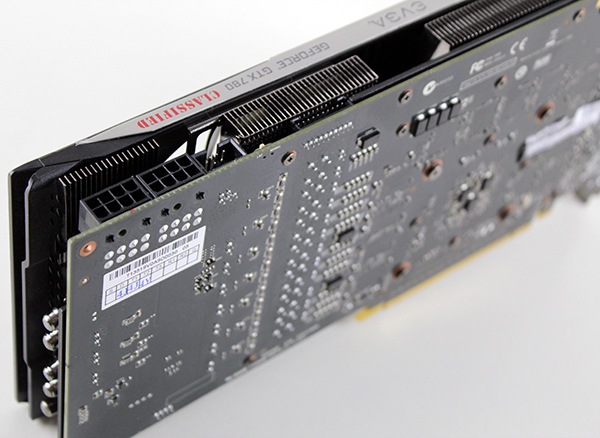
The EVBOT hand-held controller does not ship with the card, you have to purchase it separately. However, in case you really want one, you’ll have a hard time finding it, as EVGA does not sell it on its webshop anymore. There are some interesting alternatives for overclockers and we will discuss them later.

The heatsink is cooled by to top-mounted 90mm fans.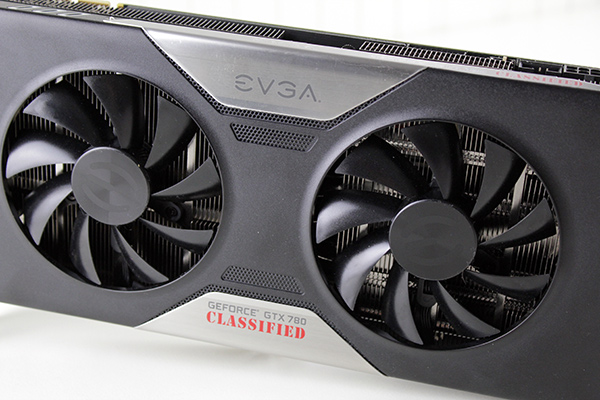
To maximize the dissipation area the heatsink was extended in all directions and reaches the edge of the PCB, which is also bigger than the reference PCB.

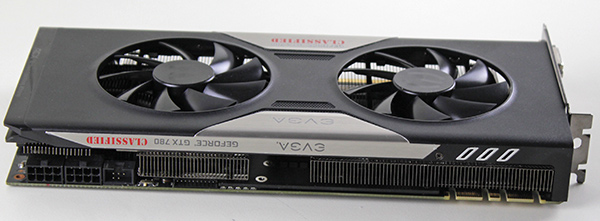
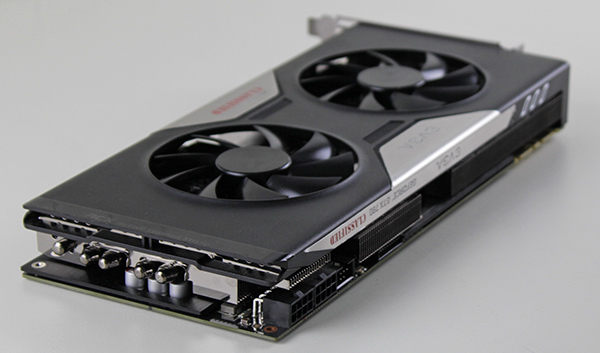
Looking at the back we see how huge this PCB really is.
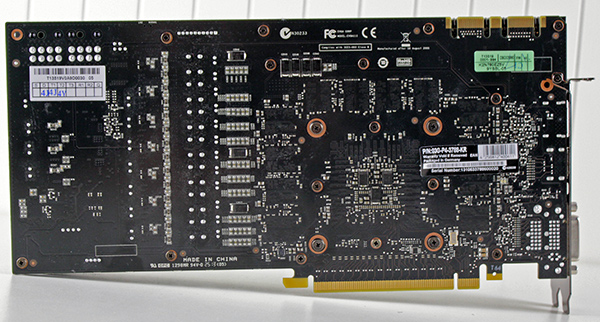
We always advise users to clean the heatsink on a regular basis. It’s good for the card and it also helps keep fan RPMs as low as possible. We thought that removing fans and accessing the heatsink will be easy but it s not.
A single screw is to blame. It holds the plastic shroud in place and it can only be removed after the EVGA logo is removed. It can be done, and the logo can be slapped back, but we are not sure whether or not the logo will ever fit the car properly once this is done, especially in the long run. A single hole in the logo would have eliminated this ridiculous issue.
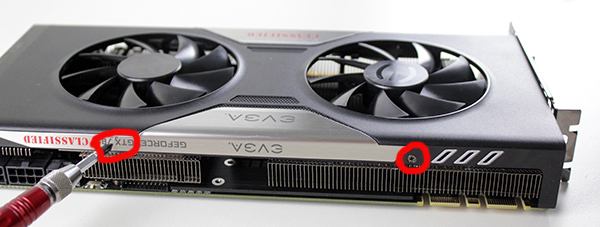
The fans can be cleaned without removing the entire cooler, you just need to undo three screws holding the fans in place. This is good news as it allows you to get better access to the heatsink without having to remove the shroud, so you should be able to clean the heatsink with compressed air, at least to some extent.

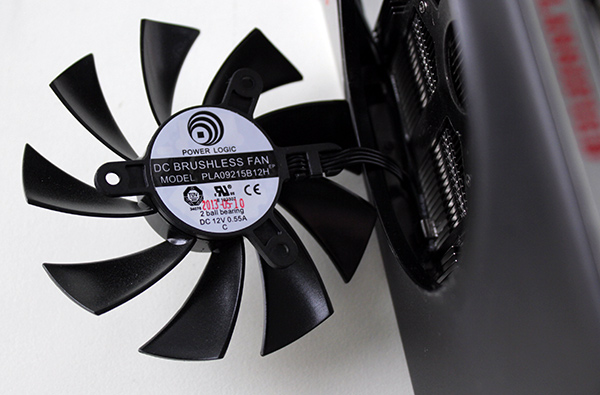
The entire cooler is attached to the PCB with four screws. As you can see the heatsink consists of two parts. EVGA calls this design the Dual Cooling Subsystem.
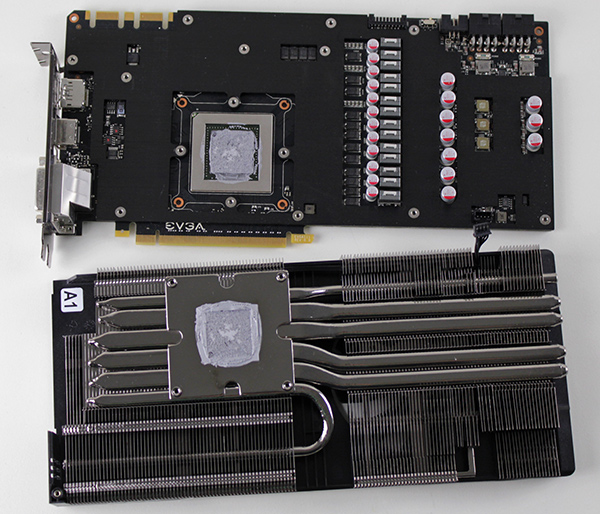
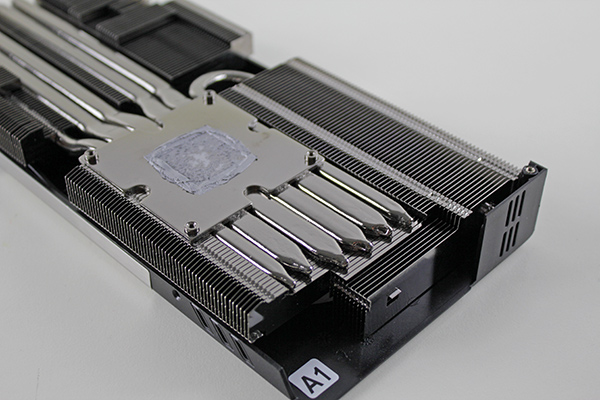
All GDDR5 memory modules are on the front side, and they are cooled by a special heatspreader which doubles as a reinforcement plate.


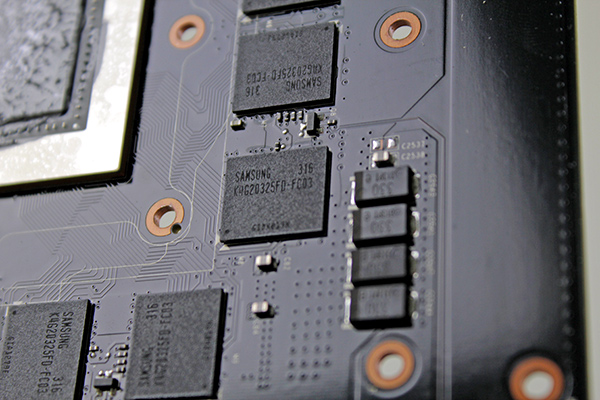
The company decided for advanced 14-phase power design (12+2).

The GTX 780 Classified features one standard HDMI connector (1.4a compatible), one standard DisplayPort out and two dual-link DVI outs. You can combine these connectors to setup a surround view.
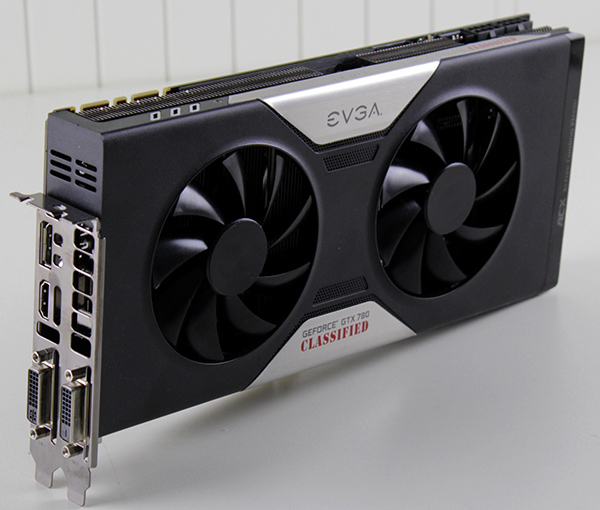
Thanks to the dual slot cooler, it is easier for enthusiasts to chain up to two or more GTX 780 Classifieds.
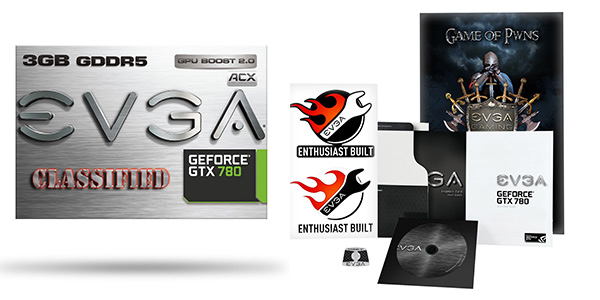
In the box you’ll find:
EVGA Full Size Poster
A User Guide and Quick Installation Guide
Driver/Software Disk
EVGA Case Badge
2x 8-pin PCI-E Power Adapters
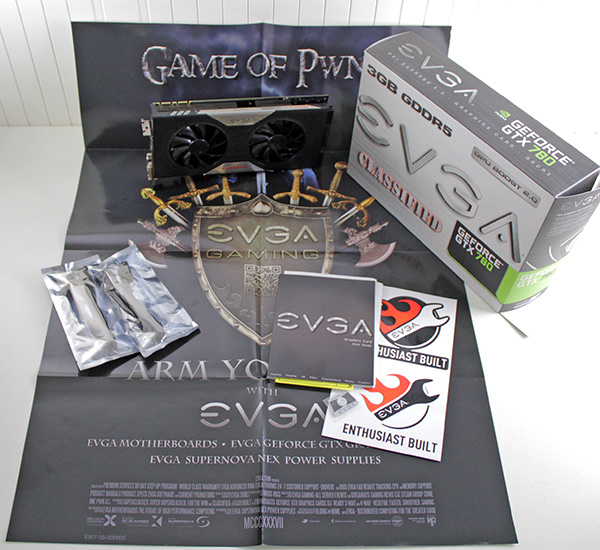
Testbed:
- Motherboard: Intel DZ87KLT-75K
- CPU: Intel Core i7 4770K, 4x3.5GHz (Haswell)
- CPU Cooler: EVGA
- Memory: 2x4GB Corsair DDR3 2400MHz
- Harddisk: Corsair Neutron GTX 240GB
- Case: CoolerMaster Cosmos II
- Operating System: Win8.1 64-bit
Drivers:
- Nvidia GeForce 337.81 BETA drivers
(GTX 780 / GTX 780 Ti / GTX 780 Classified)
- AMD Catalyst 14.4 WHQL drivers
(R9 290 / PowerColor PCS+ R9 290 / R9 290X / XFX R9 290X 1000M)
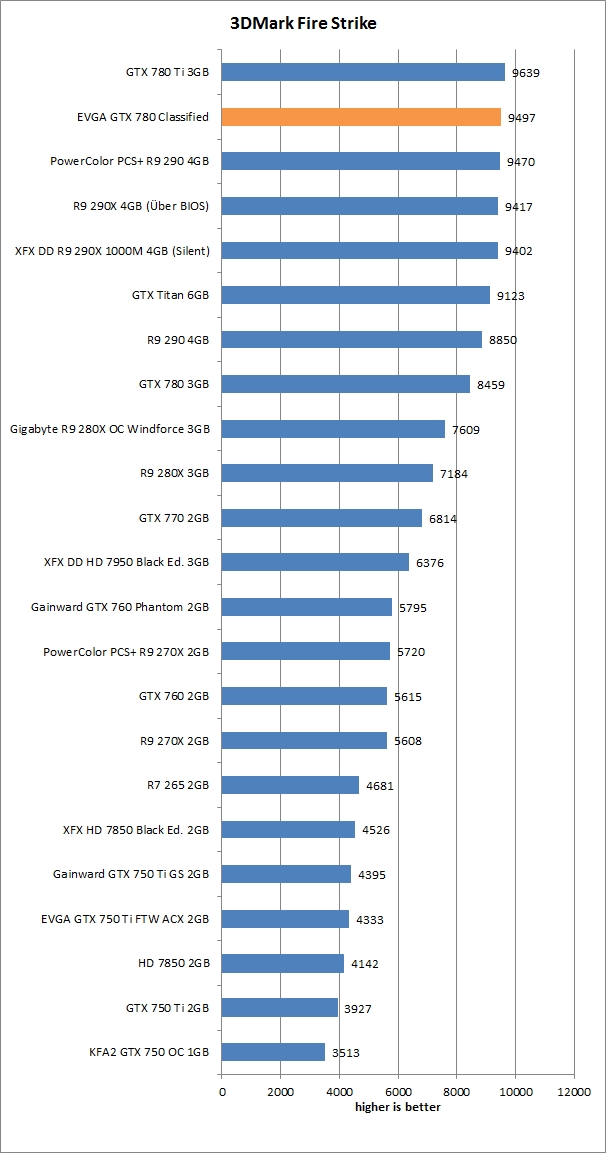
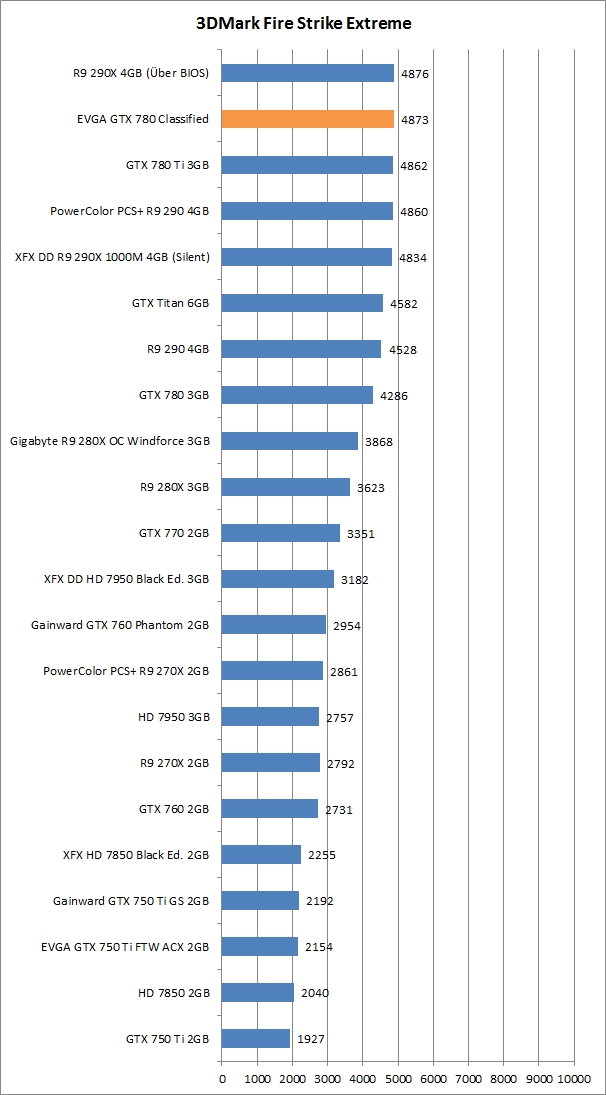
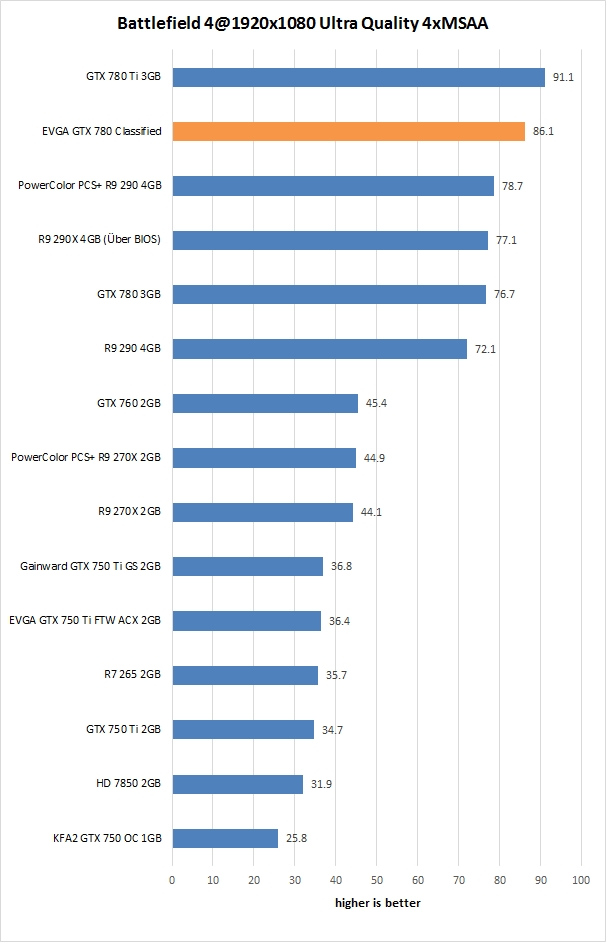
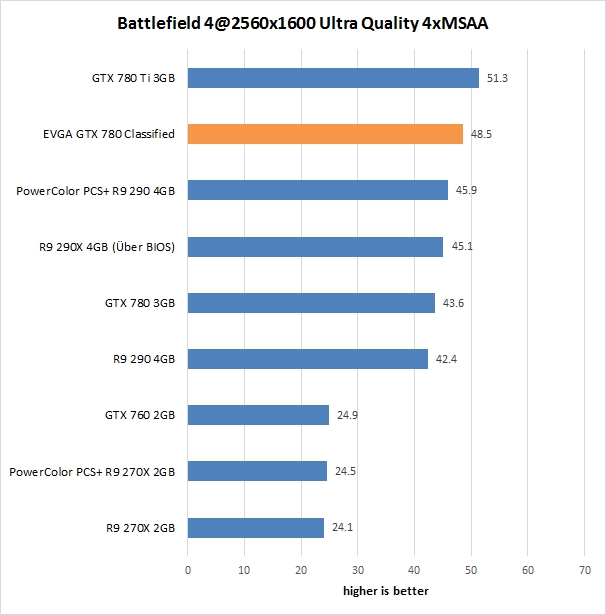
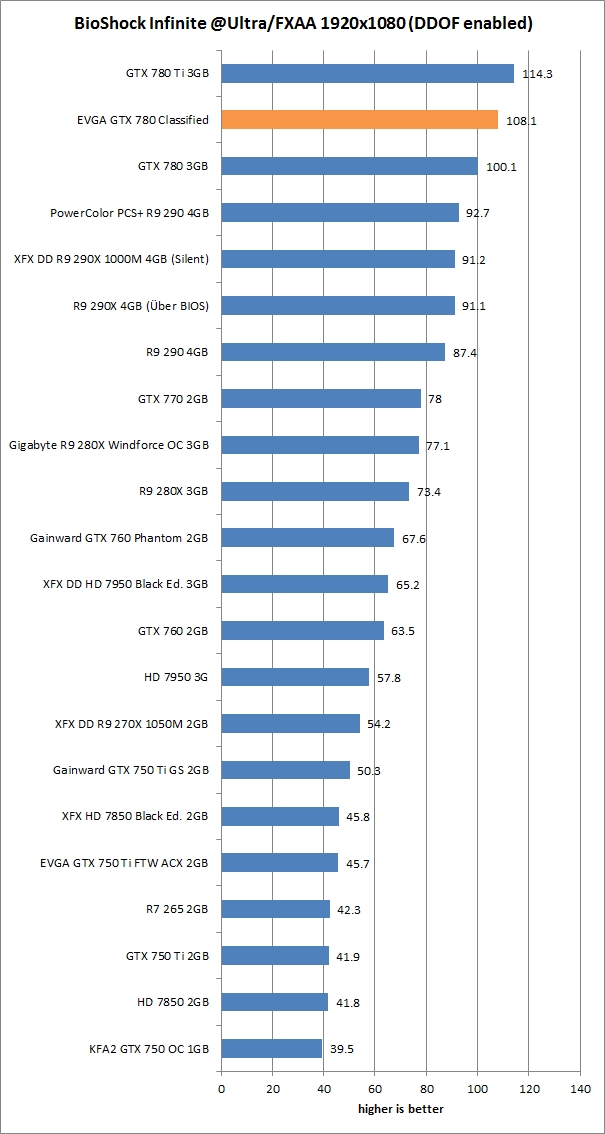
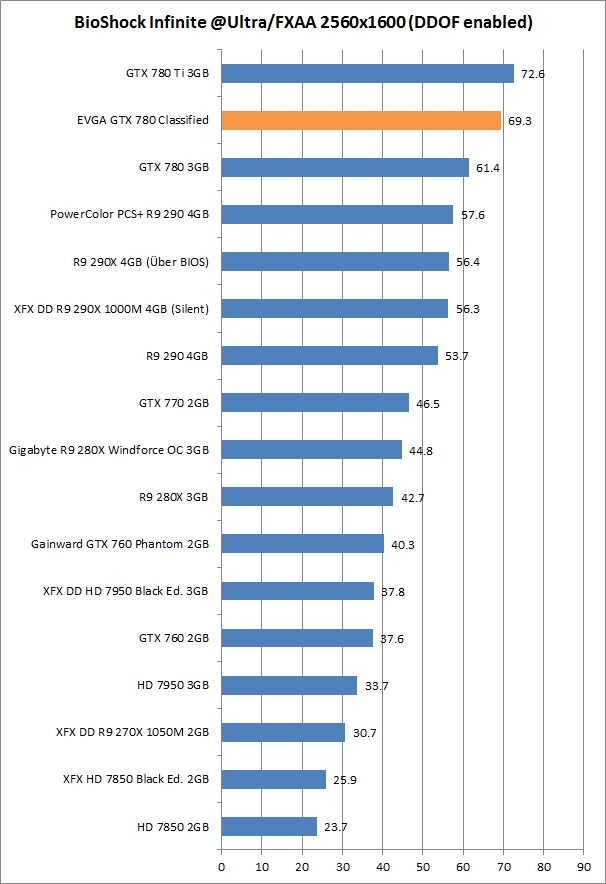

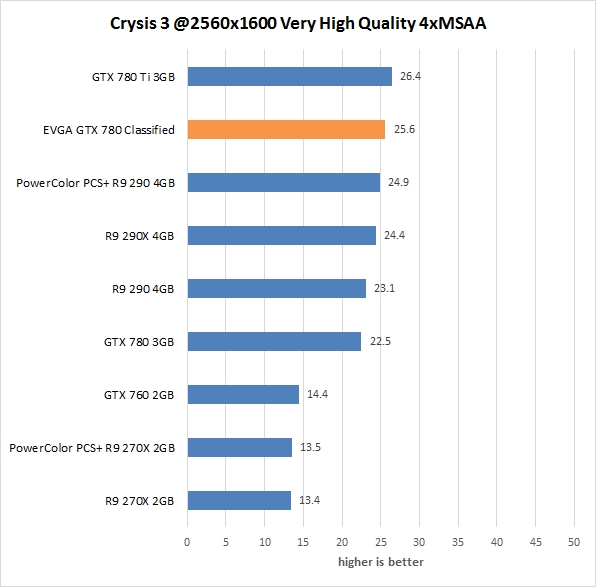
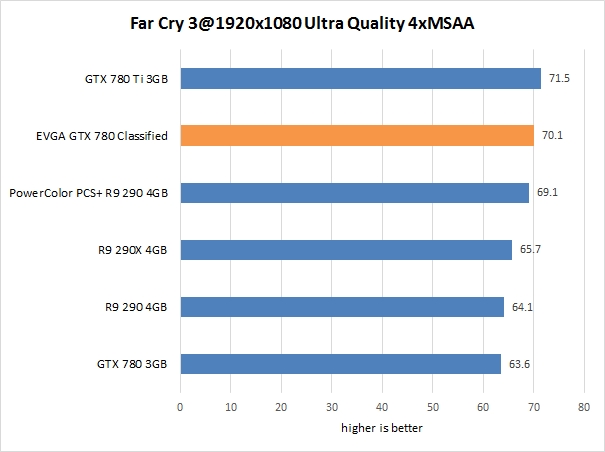

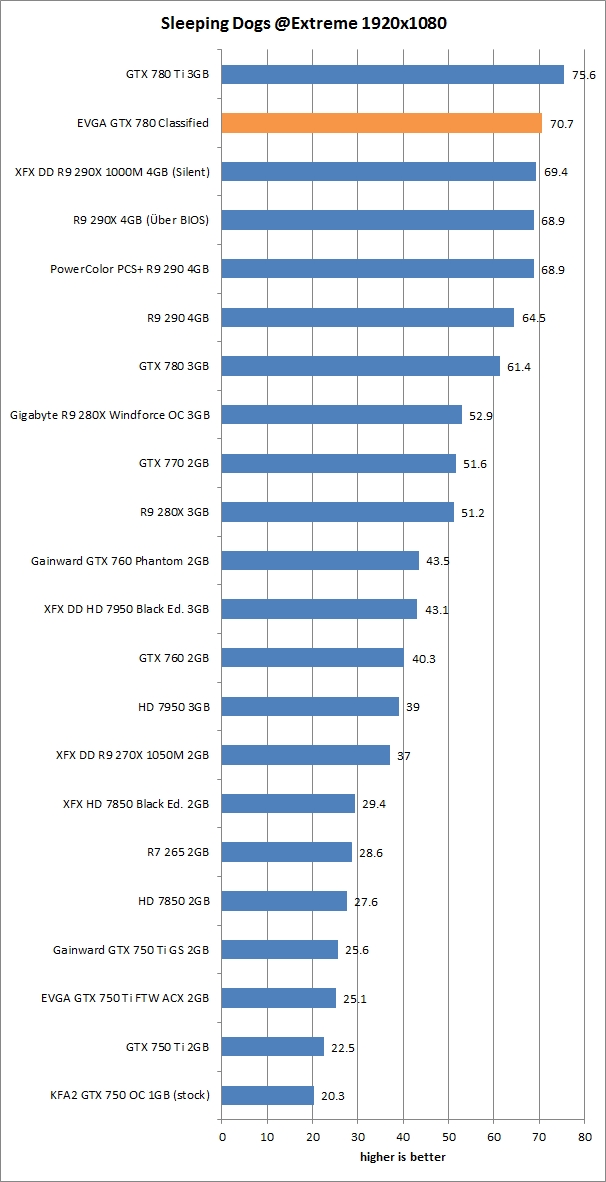
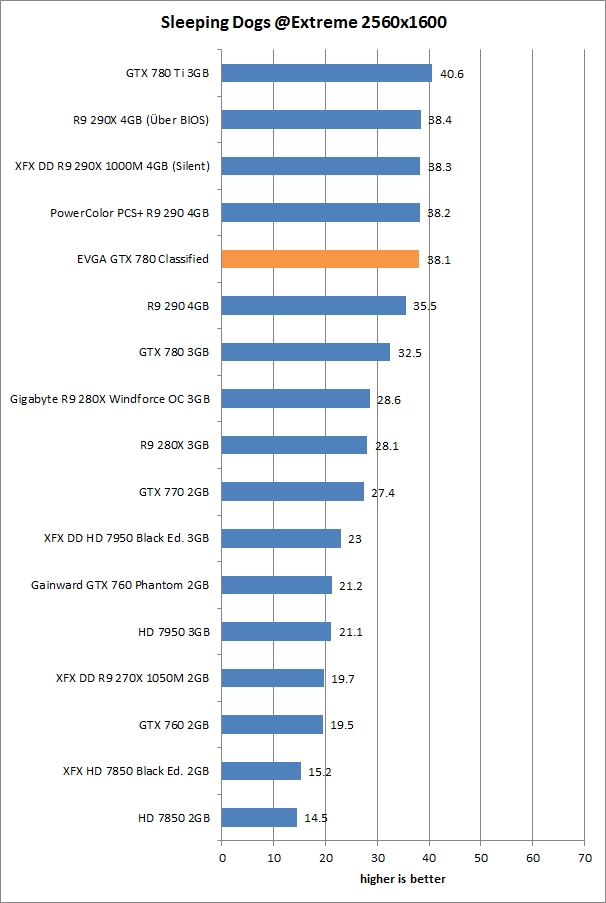
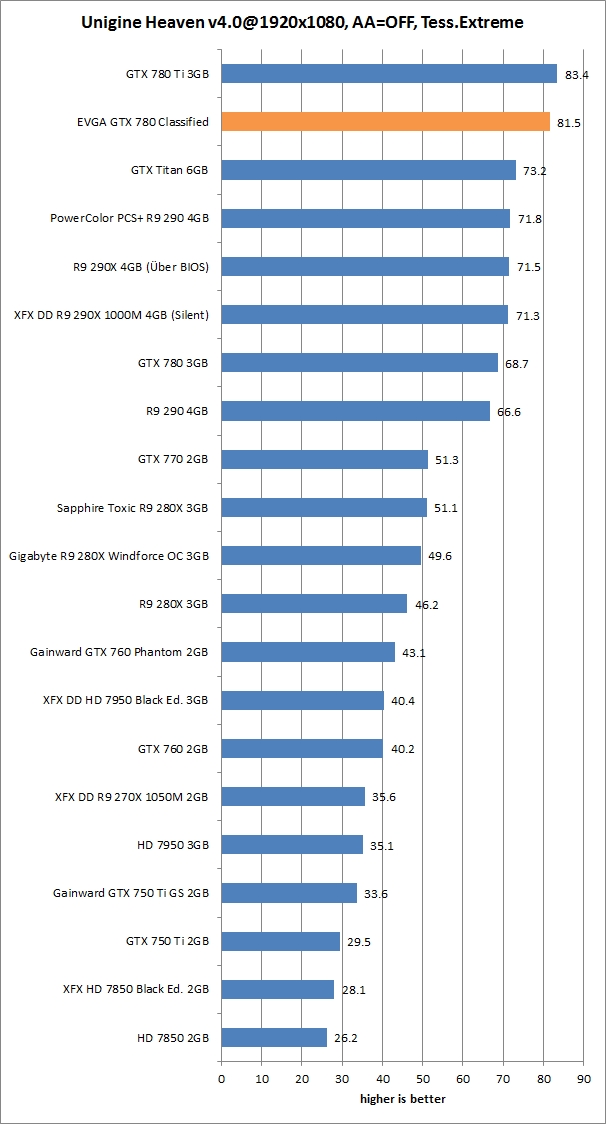
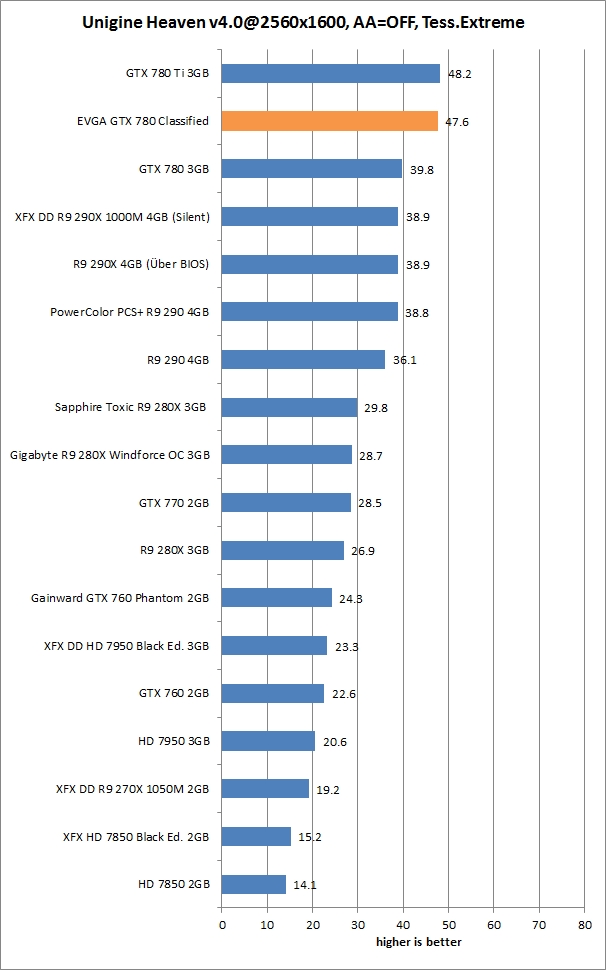
Nvidia’s reference cooler is adequate for cooling the massive GK110 chip at stock speeds. Even the more powerful GTX 780 Ti uses the same cooler. However we can confirm that the EVGA’s ACX cooler is superior to the reference design as it keeps the GPU temperatures below 75 degrees. Reference cards can easily hit 81 degrees Celsius.
The Classified is audible if you mute your PC during gaming, but it never gets very loud and it is not as loud as the reference card in 3D. In idle mode the difference is practically negligible, i.e. both cards are practically inaudible. The ACX cooler ensures your card maintains the maximum boost clock all the time.
The fan management is excellent and two 90mm fans won’t surprise you with sudden RPM changes. The fan gradually accelerates when we start a game and slowly decelerates when we’re done.
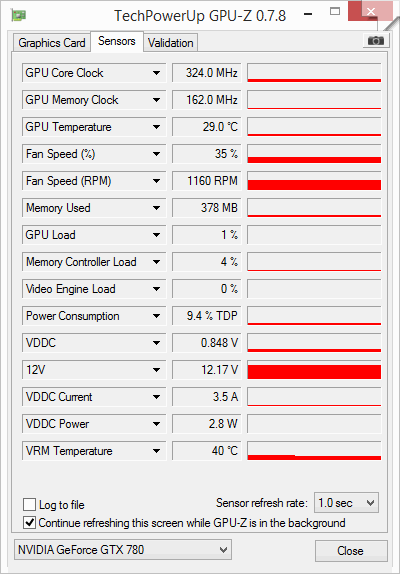
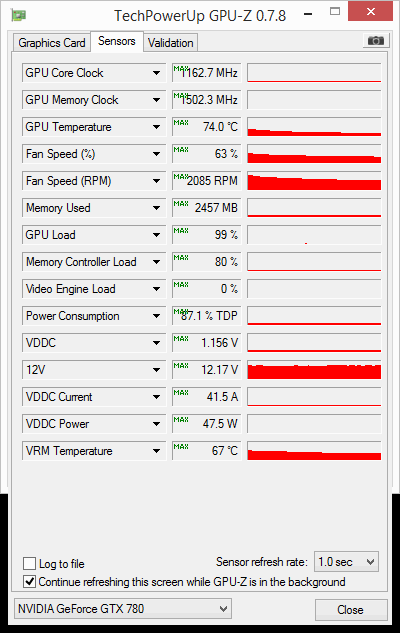
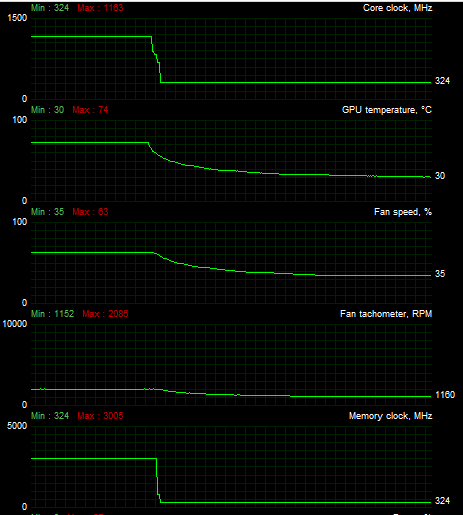
Naturally, OC results greatly depend on quality of graphics chips, since not all parts will handle extreme clocks the same way. Still, even though all graphics chips aren’t equal, you can bet that the chips running GTX 780 Classified cards will work better than average.
The GTX 780 Classified comes with a factory overclock, where the base GPU clock ended up at 993MHz (Ref. Base clock is 863MHz). Using the default fan and voltage settings as defined in the VGA BIOS we were able to raise Base GPU clock for additional 130MHz. After our little tweak, combined with GPU Boost 2.0 we saw the GTX 780 Classified inching toward the 1280MHz+ range (at stock Classified clocks the boost clock was 1163MHz).
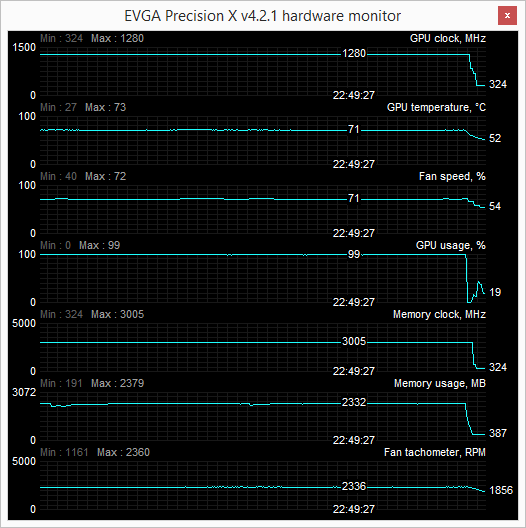
Of course, the card requires higher voltages to attain higher GPU clocks. Before we started tinkering with voltage settings, we took a peek at some readings. With an overclock of 130MHz the card stayed under 75 degrees Celsius and the fan was hitting 72% or 2360RPM. At stock clocks the fan usually runs at 63% or 2085RPM. The card was not very loud at 72%.
As we already mentioned EVBOT is no longer available directly from EVGA and if you do not have one, than it will be hard to find. Luckily the overclocker community came up with software that can easily replace the add-on. The GTX Classified Controller allows users to jack up the GPU voltage to 1.65v with no hardware mods. FBVDD and PEXVDD voltages can be increased to 1.8v and 1.242v respectively. EVGA does not official endorse the use of this clever tool. We advise users to stick to GPU voltages of up to 1.35v.
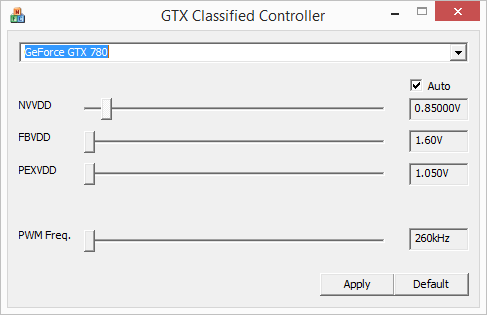
As the screenshot below indicates, the GPU voltage in PrecisionX can be increased only by a pointless 38mV.
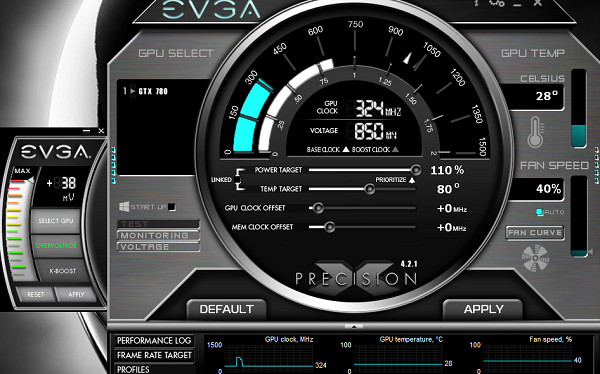
The GTX 780 Classified can easily be overclocked for fun or for superior performance. If you are looking to get higher frame rates, you need to overclock the memory, too.
A simple memory overclock boosted Sleeping Dogs frame rates by 5 percent.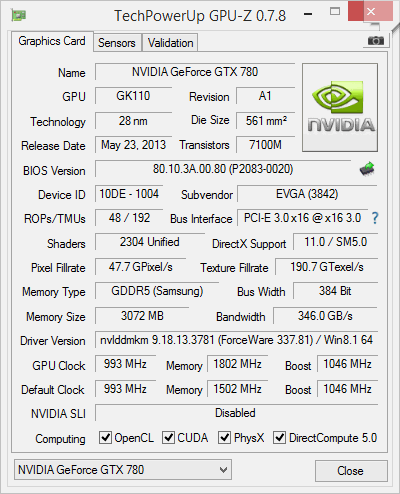
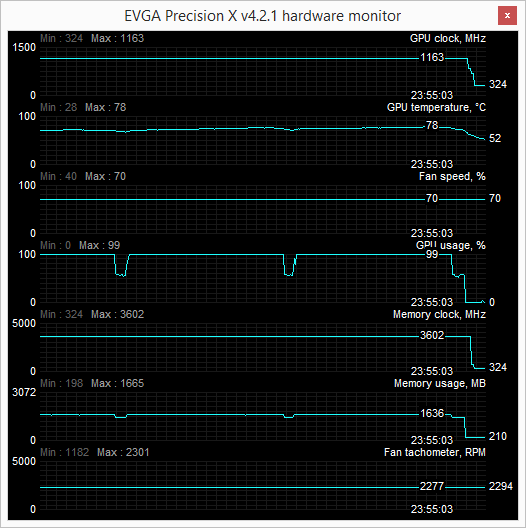
Only Memory OC
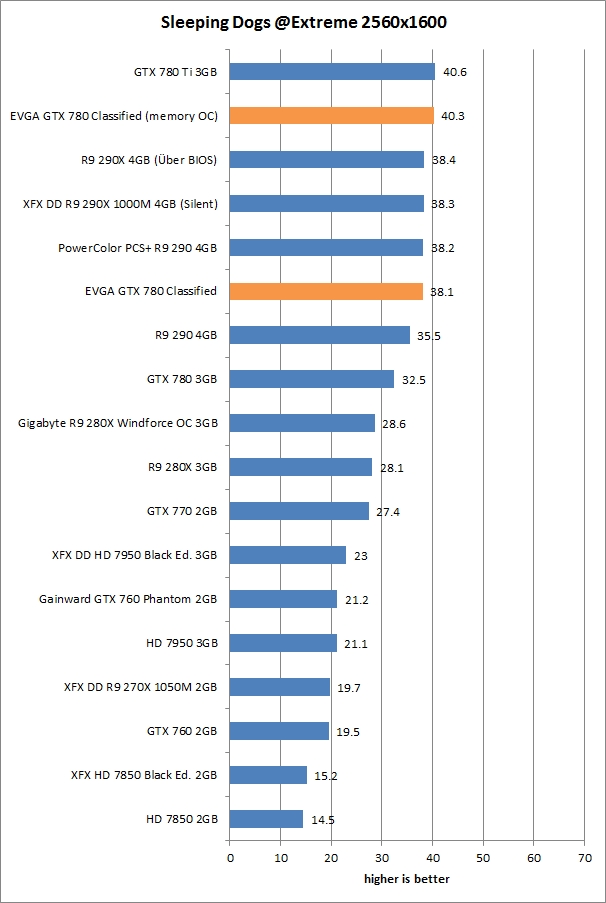
For more serious overclocking we decided to push the fan to 95% RPM and at 1.27v for the GPU we managed to attain 1380MHz. However, the clock started dropping off soon. We are confident that the card can sustain such clocks with superior cooling, i.e. a good water block or even LN2 but that’s something for extreme overclockers rather than gamers.
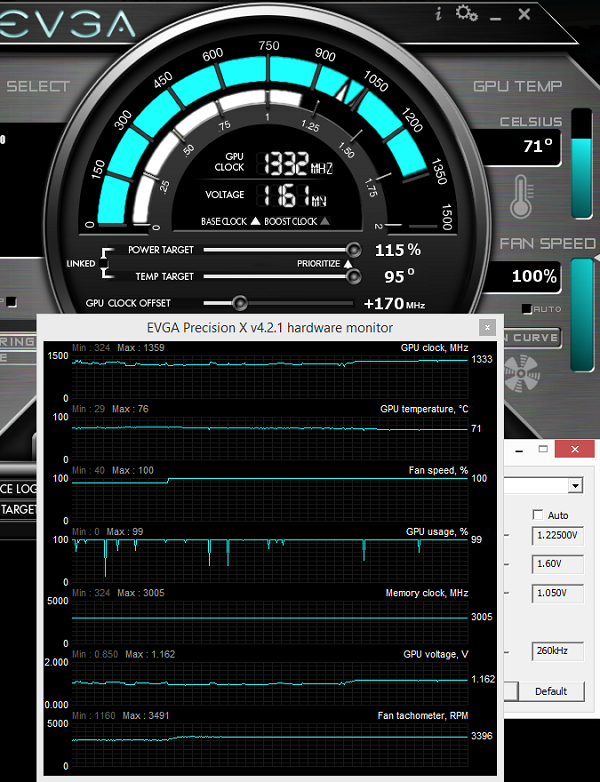
With the GPU and memory overclocked, we got the following results.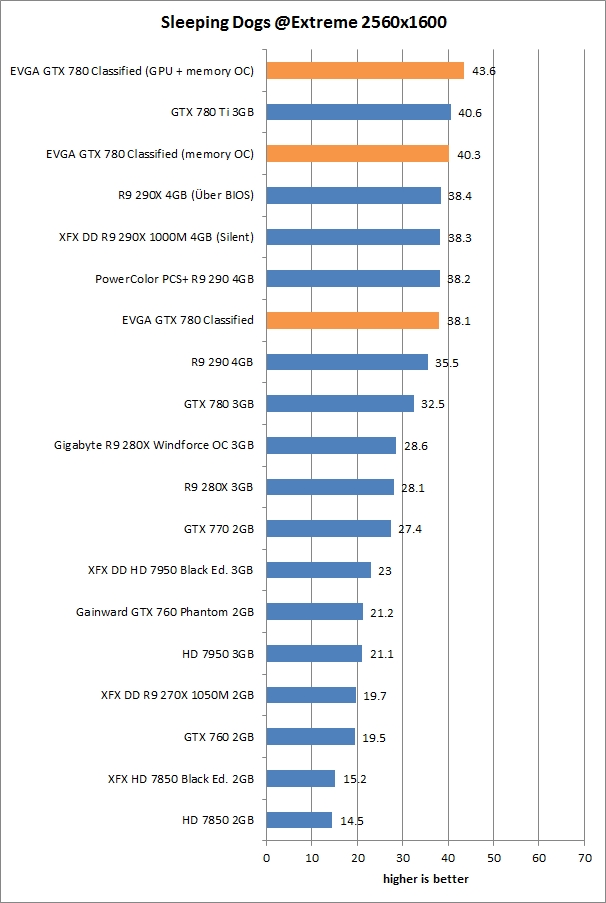
All things considered, the card does not consume too much power. Bear in mind that we are dealing with a huge GPU with 2304 shaders clocked at over 1GHz. EVGA added a second 8-pin cooler, but in reality it won’t make much of a difference for users who don’t intend to replace the cooler and start extreme overclocking.
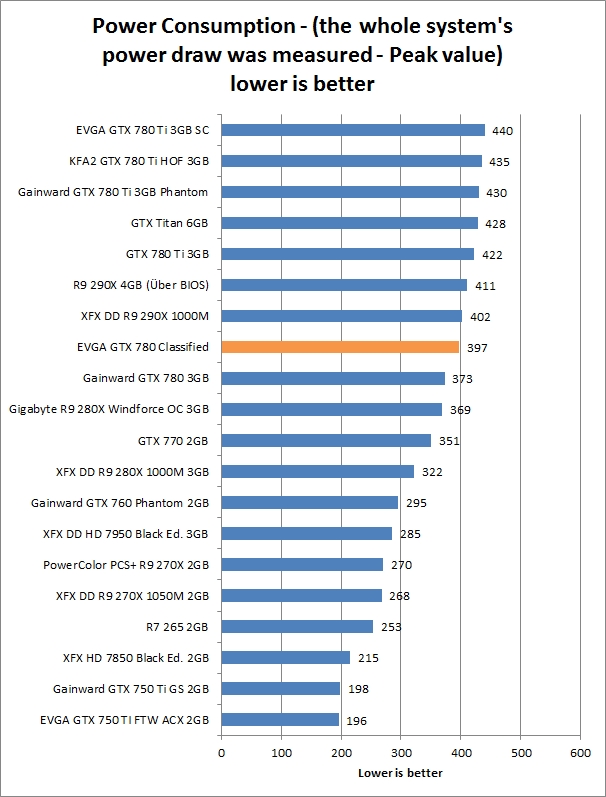
When it was introduced the GTX 780 Classified boasted the highest factory overclock of all GTX 780 cards. EVGA provided the card with a lot of muscle in all departments.
Although the GTX 780 Classified is not a new card, it has a few things going for it. It is still a very fast piece of hardware and EVGA’s custom cooled is more than sufficient. Better yet, it is a lot cheaper now that the GTX 780 Ti. The GTX 780 Classified costs about €480 in Europe, depending on the market. The reference GTX 780 Ti costs €70 more, while the GTX 780 Ti Classified can be yours if you are willing to pay a €200 premium. That’s a lot of money to burn.
The only thing holding the GTX 780 Classified’s performance back, was a set of Nvidia’s limitations that had nothing to do with EVGA. EVBOT was one of the ways to get round these limitations, but due to its relatively high price of 40-50 euro, it was discontinued. EVGA PrecisionX and MSI Afterburner tools allow only marginal GPU voltage increases. GTX Classified Control tries to mimic EVBOT functionality and it was developed by the OC community. It is not endorsed by EVGA, but it works and you can download it here. Our overclock boosted Sleeping Dogs frame rates by additional 14 percent, or 34 percent better than the reference GTX 780.
With all that in mind the GTX 780 Classified is still a good choice, as it offers relatively good value compared to GTX 780 Ti cards. With an all-custom PCB, great air cooler and with a lot of tweaking features this card is surely worth considering if you’re looking for top notch performance and quality components.

